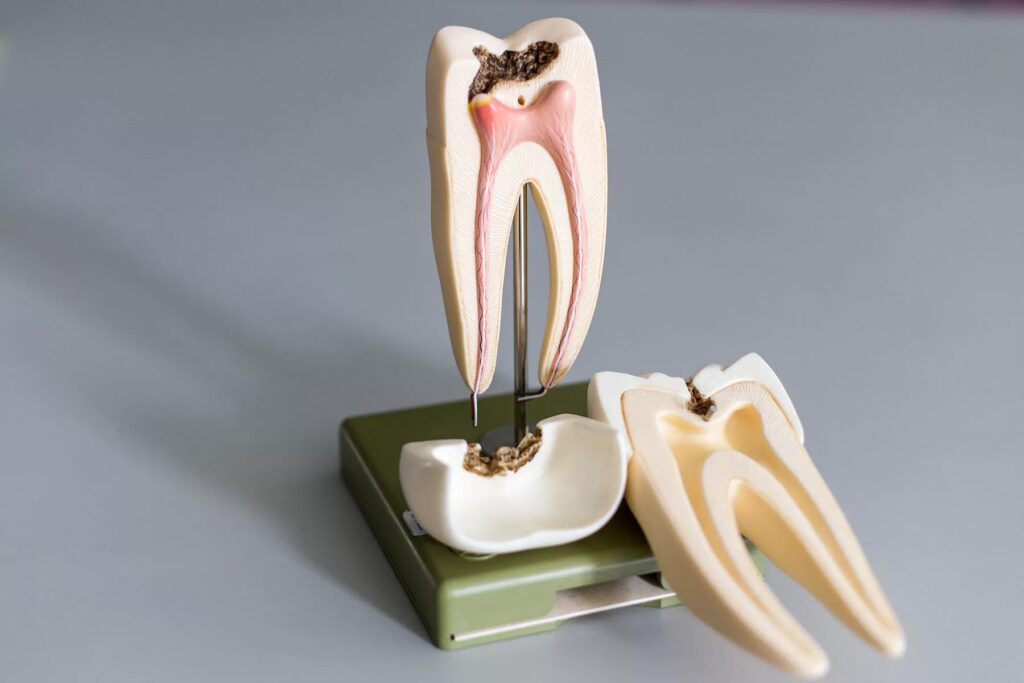
Have you recently been told that you need a root canal? If you are suffering from a toothache or the dentist has discovered deep decay within the tooth, then it might be necessary to use this modern dental treatment to save your tooth. It’s understandable that you are asking questions about the root canal before and after when preparing for this appointment.
Root Canal: Before and After the Appointment
There are several things that will happen before and after your root canal:
- Before a Root Canal: You will likely notice a few symptoms and you might be wondering if there is a problem with your tooth. You should schedule a dental exam as soon as possible. Our dental team will determine the extent of the issue and let you know if fillings or a root canal is needed.
- During the Root Canal: When you are sitting in the dental chair, you can relax knowing that our team is using modern dental practices to ensure your comfort. Sometimes, nitrous oxide is used or other types of sedation. The tooth is always numbed using a local anesthetic, so you won’t feel any pain while the dentist is working. Modern tools and equipment make a root canal treatment almost as simple and easy as a basic filling!
- After a Root Canal: Immediately after the appointment, your gums and teeth will be numb for a few hours. You’ll want to avoid eating during this time. Patients often notice that their mouth is a bit sensitive in the next few days after the appointment. But the tenderness will alleviate, and you will feel better than ever.
One thing you will notice with your root canal before and after is that you may be in a lot of discomfort before the treatment. But the pain will subside after the root canal is over. The discomfort during the healing time is insignificant compared to the severe pain experienced before the root canal treatment!
Restorations for Teeth With Root Canals
Rest assured knowing that your tooth will look and feel as normal after the root canal treatment is over. We use tooth-colored materials for the crown. The goal is to make the treated tooth blend in with the rest of your smile, especially if it is a front tooth root canal.
Root Canals: What Are They?
If you look at root canal pictures, you can see how the tooth is hollowed out to eliminate the infection and decay within the tooth. During this treatment, the dentist drills into the tooth to access the inner space of the tooth known as the root structure or root system. In this area, there are connective tissues, nerves, blood veins, and tooth pulp tissue.
If bacteria reach this inner part of the tooth, then a serious infection can develop. Historically, the only treatment option was to extract the tooth to prevent the infection from spreading. If the infected tooth is left untreated, then the bacteria and infection can move into the surrounding tissues, including the bone and blood vessels.
Now, modern dental practices can be used to eliminate the inner infection while still keeping the structure of the tooth in place. The dentist drills into the tooth, carefully removes the inner pulp and tissues, sanitizes the area, and then seals it up again with a protective filling.
How Many Appointments Are Needed for a Root Canal Treatment?
Often, root canals can be completed in a single appointment, only requiring an hour or two to finish the treatment. But there are times when two visits are necessary. In this situation, there might be a more serious infection. So, the dentist will perform the root canal and apply an antibiotic treatment to the inside of the tooth, with a temporary crown placed over the tooth.
Then, you will come back to the office for your second appointment. The dentist will remove the antibiotic packed inside, seal and fill the inside of the tooth, and place the permanent restoration over the tooth.
How to Tell if You Need a Root Canal
Most people can’t see a visible difference between a dead tooth root canal before and after. But they feel much better after this treatment is finished. Here are some of the “before” symptoms that could be an indication that you need a root canal:
- Toothache: Do you have pain in a tooth that doesn’t go away? It could mean that you have an infection within the tooth that needs to be treated.
- Temperature Sensitivity: Pay attention to how your tooth feels when exposed to cold and hot temperatures. Increased sensitivity is an indicator of a problem.
- Tooth Discoloration: Sometimes, a tooth will become discolored due to the infection.
- Bleeding or Swollen Gums: If the infection is affecting the gums, then you may notice that the tissue around the tooth is swollen and bleeds while you are brushing or flossing.
- Damage to the Tooth: When a tooth is broken or cracked, it opens a place where bacteria can lodge within the tooth and cause an infection.
If you have any symptoms, then the most important thing you should do is reach out to our team to schedule an appointment. We’ll identify the problem and help you decide if a root canal or other treatments are needed.
Recovery Tips After a Root Canal
There are a few things you can do to support your recovery after the root canal treatment:
- Brush and floss as normal
- Avoid hard foods and eat soft foods instead, such as fruit, soup, oats, smoothies, and yogurt
- Pay attention to the symptoms and contact your dentist if there is unusual bleeding or swelling
Our team is always here to answer your questions if you need any more information about root canal treatments. Reach out before/after root canal treatment for information about the services, recovery recommendations, and more.
Talk to the Root Canal Experts
Do you have additional questions about your root canal before and after? Then contact Cosmetic & Family Dentistry of Las Colinas to schedule a consultation.
- Awareness16
- Bad Breath1
- Bone Grafting1
- Braces4
- Causes, Symptoms, And Treatments6
- Cavities5
- Chewing Gum1
- Cosmetic Dentistry of Las Colinas15
- COVID-192
- Deep Cleaning7
- Dental Anxiety1
- Dental Bridge2
- Dental Care27
- Dental Cleaning6
- Dental Crown1
- Dental Filling1
- Dental Health24
- Dental Implants6
- Dental Sedation1
- Dental Visit1
- Dental X Ray3
- Floss1
- Gum Dieseases4
- Injury1
- Insurance1
- Invisalign8
- Oral Cancer1
- Oral Hygiene24
- Root Canal9
- Sleep Apnea2
- Tartar1
- Teeth19
- Thanksgiving1
- TMJ1
- Tongue1
- Veneers2
- White Teeth12
Get Your Best Smile With Us
